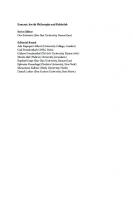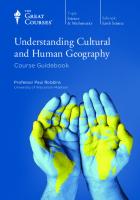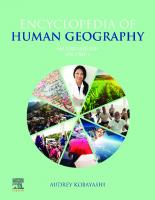Human Geography For Dummies 9781394208296, 9781394208272, 9781394208289
Your map to understanding human geography Human Geography For Dummies introduces you to the ideas and perspectives enco
134 42 25MB
English Pages 400 Year 2024
Table of contents :
About This book
How This Book Is Organized
Foolish Assumptions
Conventions Used in This Book
Icons Used in This Book
Beyond the Book
Where to Go from Here
Part 1: Introduction to Human Geography
Chapter 1: Welcome to Human Geography
Important Context for Learning Human Geography
Why Learn Human Geography?
Roadmap for This Book
Chapter 2: The History of Human Geography
A Brief History of Geography
Modern Geographies: Not Just Maps!
Chapter 3: The Five Themes of Geography
Place and Making Sense of It
Location, Location, Location
Regions Connect Us
Movement and Spatial Connections
Human-Environment Interaction
Chapter 4: The Philosophies of Geography
Putting Humans Back Into Geography
A Quantitative Approach
Geography for All: Marginalized Groups
Part 2: The Geography of Human Habitation
Chapter 5: Where Are the People?
Establishing Terms
Demography and the Study of Human Populations
Modeling Population Patterns
Chapter 6: Where the People Aren’t
Understanding Population Trends
Using Demographics to Plan for the Future
Chapter 7: Where the People Are Going
Trends and Patterns of Human Migration
Processes of Migration
Chapter 8: Why the People Are Going
Going by Choice
Going with No Other Choice
Chapter 9: Where the People Are Concentrated
Defining the Urban Area
Urban Growing Pains
Chapter 10: Where People Live
Living in the Countryside
Big City Living
Part 3: The Spatial Organization of Human Systems
Chapter 11: How a People Become a Culture
Process of Cultural Development
Making a mark on the geographic landscape
Chapter 12: How a Culture Spreads
Processes of Cultural Diffusion
Reactions to Cultural Diffusion
Chapter 13: Establishing a State
Stating the state of the State
Stating the Shape of a State
Chapter 14: What a State Faces from Within
Centripetal Forces — Uniting a People
Centrifugal Forces — Pulling a State Apart
Chapter 15: Withstanding Outside Forces on a State
States Playing Nice (or Not)
We Are the World
Part 4: The Spatial Organization of Human Economic Systems
Chapter 16: The People Need Food
Origins of Agriculture
Agriculture Grows and Spreads
Agribusiness
Agricultural Location
Chapter 17: The People Need More Food
Agricultural Distributions
Chapter 18: The People Need Economic Opportunities
The Precursors to Development
Developmental Geography
Chapter 19: The People Need Goods and Services
Industry of the Past
Industry of the Present
Industrial Regions of the Now
People and Profit
Updated Manufacturing and Business Practices
Chapter 20: The People Need a Healthy Environment
Going Green
Global Solutions to a Global Issue
Part 5: The Part of Tens
Chapter 21: Ten Human Geography Careers
The Academic Route
The Geospatial Route
The Business Route
The Medical Route
The Military/Intelligence Route
The Education Route
The City/County Government Route
The Marketing Route
The Conservationist Route
The Travel and Tourism Route
Chapter 22: Ten Places to Visit to See Human Geography in Action
A Major World City
A Large Regional City
Another Country
A State or National Capital
A Rural Area
A “Natural” Area
A Small Town
An Isolated Settlement or Village
An Airport, Train Station, or Bus Station
Your Own Community
Index
About the Author
Connect with Dummies
End User License Agreement
List of Illustrations
Chapter 1
FIGURE 1-1: Get out and explore. You never know what a new perspective will get...
Chapter 2
FIGURE 2-1: The Babylonia Clay tablet map by Bruno Meissner. (Image source: pub...
FIGURE 2-2: Re-creation of Anaximander’s world map
FIGURE 2-3: Mercator’s 1569 World Map. (Image source: www.alamy.com.)
FIGURE 2-4: Dr. John Snow’s 1854 cholera map of London. (Image source: public d...
Chapter 3
FIGURE 3-1: The city of Listvyanka on the shores of Lake Baikal
FIGURE 3-2: Downtown Omaha, Nebraska in winter finery
FIGURE 3-3: People dodging the heat in Cologne, Germany, in the relief of shade...
Chapter 5
FIGURE 5-1: Changes in population from 2010 to 2020. (Photo Credit: US Census B...
FIGURE 5-2: Looking at this map with a simplified scale, you can see the tight ...
FIGURE 5-3: The Demographic Transition Model (DTM)
FIGURE 5-4: Niger’s population pyramid. (Image source: The World Factbook.)
FIGURE 5-5: Singapore’s population pyramid (Image source: The World Factbook)
Chapter 6
FIGURE 6-1: World population density
FIGURE 6-2: The desert of Utah is not seen fit for human habitation, so it has ...
FIGURE 6-3: Würzburg, Germany, on the shores of the Main River
FIGURE 6-4: Shanghai, China
FIGURE 6-5: Thunder Basin National Grasslands, in Eastern Wyoming
FIGURE 6-6: An homage to Karl Marx in Chemnitz, Germany (formerly Karl-Marx Sta...
Chapter 7
FIGURE 7-1: Some sort of songbird egg for dinner in Hangzhou, China
FIGURE 7-2: A sign in London’s Luton Airport with instructions for newly arrive...
FIGURE 7-3: A historical marker for the Fort Laramie-Fort Robinson Trail near H...
FIGURE 7-4: A monument to the HMT Windrush in London’s Waterloo Station
Chapter 8
FIGURE 8-1: A political cartoon about the changing immigration quota system in ...
FIGURE 8-2: An anti-immigration rally in Eastern Bharat (India) against immigra...
FIGURE 8-3: Refugees and asylum seekers by host country in 1997. (Source: Insti...
Chapter 9
FIGURE 9-1: Christaller’s Central Place Theory
FIGURE 9-2: Chinatown in London. The Chinese lanterns and high density of resta...
FIGURE 9-3: The Eifel Tower, an Icon of French culture. (Photo credit: Jill Mue...
FIGURE 9-4: Skagway, Alaska
FIGURE 9-5: The famous Broad Street Pump, now enshrined in front of the John Sn...
Chapter 10
FIGURE 10-1: The metes and bounds cadastral system
FIGURE 10-2: The long-lot cadastral system
FIGURE 10-3: The township and range system
FIGURE 10-4: Rural village types
FIGURE 10-5: North American city models
FIGURE 10-6: The Griffin-Ford Latin-American city model
FIGURE 10-7: The de Blij sub-Saharan city model
FIGURE 10-8: The Southwest Asia/Islamic city model
FIGURE 10-9: The Southeast Asia city model
Chapter 11
FIGURE 11-1: Traditional art represented in Gyeongbokgung Palace in Central Seo...
FIGURE 11-2: A broadly generalized map showing the distributions of language fa...
FIGURE 11-3: Major world religions
FIGURE 11-4: Jamia mosque in downtown Nairobi, Kenya
FIGURE 11-5: Placelessness embodied in photographic form
FIGURE 11-6: Image of a place that is less nondescript
Chapter 12
FIGURE 12-1: Diffusion of the four major religions
FIGURE 12-2: The Victoria and Albert Harbour in Cape Town, South Africa
FIGURE 12-3: Gandantegchinlen Tibetan Buddhism Monastery in Ulaanbaatar, Mongol...
FIGURE 12-4: A pizza menu in Seoul, South Korea. (Photo courtesy of Jill Muegge...
FIGURE 12-5: Piccadilly Circus in Central London
FIGURE 12-6: The Neukölln borough in Berlin, Germany
FIGURE 12-7: Cityscape of Amman, Jordan
Chapter 13
FIGURE 13-1: Distribution of federal and unitary States in 2023
FIGURE 13-2: Contested region of Nagorno-Karabakh
FIGURE 13-3: Checkpoint Charlie
FIGURE 13-4: Territorial morphology examples
Chapter 14
FIGURE 14-1: The devolution of Europe
Chapter 15
FIGURE 15-1: Mackinder’s rendering of the Pivot Point as the crucial point of c...
Chapter 16
FIGURE 16-1: Early plant domestication by region
FIGURE 16-2: The Von Thunen model of Agricultural Land Use with an adaptation f...
FIGURE 16-3: Icelandic fish farm near Isafjordur
Chapter 17
FIGURE 17-1: A rubber tree plantation in Thailand
FIGURE 17-2: Terraced rice paddy in Vietnam
FIGURE 17-3: A vineyard in Tuscany, Italy
FIGURE 17-4: GIS in agriculture
Chapter 18
FIGURE 18-1: Weber’s Model of Industrial Location
FIGURE 18-2: A representation of the status of States in about 2000 according t...
Chapter 19
FIGURE 19-1: The hearth of the Industrial Revolution in Britain
FIGURE 19-2: Global manufacturing by region
FIGURE 19-3: The division of the world between the Core, Periphery, and Semi-Pe...
FIGURE 19-4: Changes in transportation times over time
Chapter 20
FIGURE 20-1: The Icelandic culture of fishing
FIGURE 20-2: A Chinese pangolin in the Leipzig Zoo. (Image source: public domai...
FIGURE 20-3: North Antelope Rochelle Coal Mine in Wyoming, as seen from space. ...
FIGURE 20-4: Areas at risk from desertification
FIGURE 20-5: Toucans in Manuel Antonio National Park in Costa Rica
About This book
How This Book Is Organized
Foolish Assumptions
Conventions Used in This Book
Icons Used in This Book
Beyond the Book
Where to Go from Here
Part 1: Introduction to Human Geography
Chapter 1: Welcome to Human Geography
Important Context for Learning Human Geography
Why Learn Human Geography?
Roadmap for This Book
Chapter 2: The History of Human Geography
A Brief History of Geography
Modern Geographies: Not Just Maps!
Chapter 3: The Five Themes of Geography
Place and Making Sense of It
Location, Location, Location
Regions Connect Us
Movement and Spatial Connections
Human-Environment Interaction
Chapter 4: The Philosophies of Geography
Putting Humans Back Into Geography
A Quantitative Approach
Geography for All: Marginalized Groups
Part 2: The Geography of Human Habitation
Chapter 5: Where Are the People?
Establishing Terms
Demography and the Study of Human Populations
Modeling Population Patterns
Chapter 6: Where the People Aren’t
Understanding Population Trends
Using Demographics to Plan for the Future
Chapter 7: Where the People Are Going
Trends and Patterns of Human Migration
Processes of Migration
Chapter 8: Why the People Are Going
Going by Choice
Going with No Other Choice
Chapter 9: Where the People Are Concentrated
Defining the Urban Area
Urban Growing Pains
Chapter 10: Where People Live
Living in the Countryside
Big City Living
Part 3: The Spatial Organization of Human Systems
Chapter 11: How a People Become a Culture
Process of Cultural Development
Making a mark on the geographic landscape
Chapter 12: How a Culture Spreads
Processes of Cultural Diffusion
Reactions to Cultural Diffusion
Chapter 13: Establishing a State
Stating the state of the State
Stating the Shape of a State
Chapter 14: What a State Faces from Within
Centripetal Forces — Uniting a People
Centrifugal Forces — Pulling a State Apart
Chapter 15: Withstanding Outside Forces on a State
States Playing Nice (or Not)
We Are the World
Part 4: The Spatial Organization of Human Economic Systems
Chapter 16: The People Need Food
Origins of Agriculture
Agriculture Grows and Spreads
Agribusiness
Agricultural Location
Chapter 17: The People Need More Food
Agricultural Distributions
Chapter 18: The People Need Economic Opportunities
The Precursors to Development
Developmental Geography
Chapter 19: The People Need Goods and Services
Industry of the Past
Industry of the Present
Industrial Regions of the Now
People and Profit
Updated Manufacturing and Business Practices
Chapter 20: The People Need a Healthy Environment
Going Green
Global Solutions to a Global Issue
Part 5: The Part of Tens
Chapter 21: Ten Human Geography Careers
The Academic Route
The Geospatial Route
The Business Route
The Medical Route
The Military/Intelligence Route
The Education Route
The City/County Government Route
The Marketing Route
The Conservationist Route
The Travel and Tourism Route
Chapter 22: Ten Places to Visit to See Human Geography in Action
A Major World City
A Large Regional City
Another Country
A State or National Capital
A Rural Area
A “Natural” Area
A Small Town
An Isolated Settlement or Village
An Airport, Train Station, or Bus Station
Your Own Community
Index
About the Author
Connect with Dummies
End User License Agreement
List of Illustrations
Chapter 1
FIGURE 1-1: Get out and explore. You never know what a new perspective will get...
Chapter 2
FIGURE 2-1: The Babylonia Clay tablet map by Bruno Meissner. (Image source: pub...
FIGURE 2-2: Re-creation of Anaximander’s world map
FIGURE 2-3: Mercator’s 1569 World Map. (Image source: www.alamy.com.)
FIGURE 2-4: Dr. John Snow’s 1854 cholera map of London. (Image source: public d...
Chapter 3
FIGURE 3-1: The city of Listvyanka on the shores of Lake Baikal
FIGURE 3-2: Downtown Omaha, Nebraska in winter finery
FIGURE 3-3: People dodging the heat in Cologne, Germany, in the relief of shade...
Chapter 5
FIGURE 5-1: Changes in population from 2010 to 2020. (Photo Credit: US Census B...
FIGURE 5-2: Looking at this map with a simplified scale, you can see the tight ...
FIGURE 5-3: The Demographic Transition Model (DTM)
FIGURE 5-4: Niger’s population pyramid. (Image source: The World Factbook.)
FIGURE 5-5: Singapore’s population pyramid (Image source: The World Factbook)
Chapter 6
FIGURE 6-1: World population density
FIGURE 6-2: The desert of Utah is not seen fit for human habitation, so it has ...
FIGURE 6-3: Würzburg, Germany, on the shores of the Main River
FIGURE 6-4: Shanghai, China
FIGURE 6-5: Thunder Basin National Grasslands, in Eastern Wyoming
FIGURE 6-6: An homage to Karl Marx in Chemnitz, Germany (formerly Karl-Marx Sta...
Chapter 7
FIGURE 7-1: Some sort of songbird egg for dinner in Hangzhou, China
FIGURE 7-2: A sign in London’s Luton Airport with instructions for newly arrive...
FIGURE 7-3: A historical marker for the Fort Laramie-Fort Robinson Trail near H...
FIGURE 7-4: A monument to the HMT Windrush in London’s Waterloo Station
Chapter 8
FIGURE 8-1: A political cartoon about the changing immigration quota system in ...
FIGURE 8-2: An anti-immigration rally in Eastern Bharat (India) against immigra...
FIGURE 8-3: Refugees and asylum seekers by host country in 1997. (Source: Insti...
Chapter 9
FIGURE 9-1: Christaller’s Central Place Theory
FIGURE 9-2: Chinatown in London. The Chinese lanterns and high density of resta...
FIGURE 9-3: The Eifel Tower, an Icon of French culture. (Photo credit: Jill Mue...
FIGURE 9-4: Skagway, Alaska
FIGURE 9-5: The famous Broad Street Pump, now enshrined in front of the John Sn...
Chapter 10
FIGURE 10-1: The metes and bounds cadastral system
FIGURE 10-2: The long-lot cadastral system
FIGURE 10-3: The township and range system
FIGURE 10-4: Rural village types
FIGURE 10-5: North American city models
FIGURE 10-6: The Griffin-Ford Latin-American city model
FIGURE 10-7: The de Blij sub-Saharan city model
FIGURE 10-8: The Southwest Asia/Islamic city model
FIGURE 10-9: The Southeast Asia city model
Chapter 11
FIGURE 11-1: Traditional art represented in Gyeongbokgung Palace in Central Seo...
FIGURE 11-2: A broadly generalized map showing the distributions of language fa...
FIGURE 11-3: Major world religions
FIGURE 11-4: Jamia mosque in downtown Nairobi, Kenya
FIGURE 11-5: Placelessness embodied in photographic form
FIGURE 11-6: Image of a place that is less nondescript
Chapter 12
FIGURE 12-1: Diffusion of the four major religions
FIGURE 12-2: The Victoria and Albert Harbour in Cape Town, South Africa
FIGURE 12-3: Gandantegchinlen Tibetan Buddhism Monastery in Ulaanbaatar, Mongol...
FIGURE 12-4: A pizza menu in Seoul, South Korea. (Photo courtesy of Jill Muegge...
FIGURE 12-5: Piccadilly Circus in Central London
FIGURE 12-6: The Neukölln borough in Berlin, Germany
FIGURE 12-7: Cityscape of Amman, Jordan
Chapter 13
FIGURE 13-1: Distribution of federal and unitary States in 2023
FIGURE 13-2: Contested region of Nagorno-Karabakh
FIGURE 13-3: Checkpoint Charlie
FIGURE 13-4: Territorial morphology examples
Chapter 14
FIGURE 14-1: The devolution of Europe
Chapter 15
FIGURE 15-1: Mackinder’s rendering of the Pivot Point as the crucial point of c...
Chapter 16
FIGURE 16-1: Early plant domestication by region
FIGURE 16-2: The Von Thunen model of Agricultural Land Use with an adaptation f...
FIGURE 16-3: Icelandic fish farm near Isafjordur
Chapter 17
FIGURE 17-1: A rubber tree plantation in Thailand
FIGURE 17-2: Terraced rice paddy in Vietnam
FIGURE 17-3: A vineyard in Tuscany, Italy
FIGURE 17-4: GIS in agriculture
Chapter 18
FIGURE 18-1: Weber’s Model of Industrial Location
FIGURE 18-2: A representation of the status of States in about 2000 according t...
Chapter 19
FIGURE 19-1: The hearth of the Industrial Revolution in Britain
FIGURE 19-2: Global manufacturing by region
FIGURE 19-3: The division of the world between the Core, Periphery, and Semi-Pe...
FIGURE 19-4: Changes in transportation times over time
Chapter 20
FIGURE 20-1: The Icelandic culture of fishing
FIGURE 20-2: A Chinese pangolin in the Leipzig Zoo. (Image source: public domai...
FIGURE 20-3: North Antelope Rochelle Coal Mine in Wyoming, as seen from space. ...
FIGURE 20-4: Areas at risk from desertification
FIGURE 20-5: Toucans in Manuel Antonio National Park in Costa Rica






![Human geography [3 ed.]](https://ebin.pub/img/200x200/human-geography-3nbsped.jpg)
![Human Resources Kit For Dummies [4 ed.]
1119989892, 9781119989899](https://ebin.pub/img/200x200/human-resources-kit-for-dummies-4nbsped-1119989892-9781119989899.jpg)


